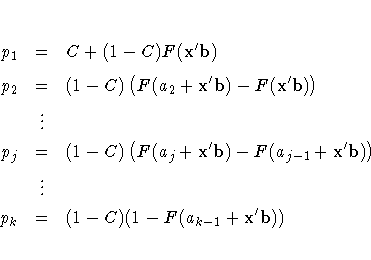Chapter Contents
Previous
Next
|
Chapter Contents |
Previous |
Next |
| The PROBIT Procedure |
For a multilevel response with outcomes labeled li for i = 1,2, ... ,k, the probability, pj, of observing level lj is as follows.

Thus, for a k-level response, there are k-2 additional parameters, a2,a3, ... ,ak-1, estimated. These parameters are denoted by INTER.j, j = 2,3, ... ,k-1 in the output.
An intercept parameter is always added to the set of independent variables as the first term in the model unless the NOINT option is specified in the MODEL statement. If a classification variable taking on k levels is used as one of the independent variables, a set of k indicator variables is generated to model the effect of this variable. Because of the presence of the intercept term, there are at most k-1 degrees of freedom for this effect in the model.
|
Chapter Contents |
Previous |
Next |
Top |
Copyright © 1999 by SAS Institute Inc., Cary, NC, USA. All rights reserved.